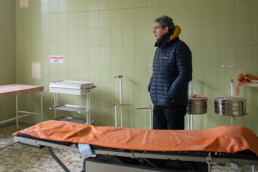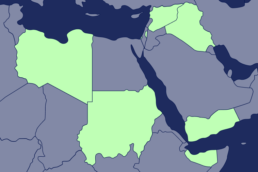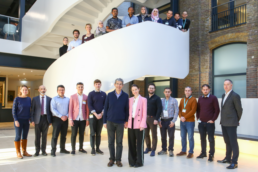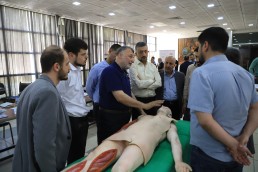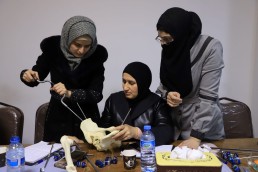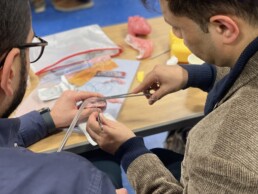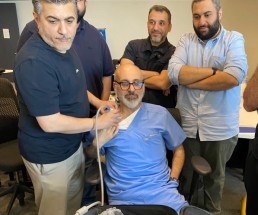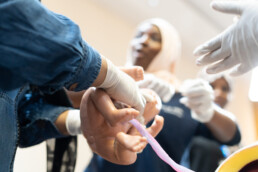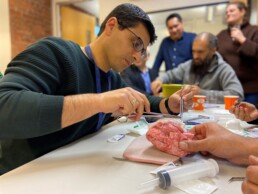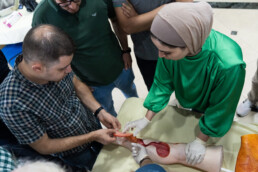Strengthening trauma response in Northwest Syria
Northwest Syria continues to face escalating hostilities, compounded by regional conflicts that have intensified instability across the area. In October 2024, airstrikes targeting Idlib resulted in numerous casualties, reflecting the ongoing humanitarian crisis. Healthcare facilities, already strained by over a decade of conflict, are now bracing for an increase in trauma cases due to anticipated surges in violence.
Amid this dire backdrop, the World Health Organization (WHO) launched a Trauma Emergency Response and Preparedness (EPREP) plan to strengthen trauma care and emergency preparedness in Northwest Syria. Recognising the David Nott Foundation’s expertise in trauma training, WHO invited us to partner in their efforts to enhance local healthcare capacity. This initiative was generously funded by USAID, whose support has been instrumental in bringing this project to life.
We are honoured to contribute through the delivery of our renowned Hostile Environment Surgical Training (HEST) course, which WHO has identified as a “central pillar” of its trauma response strategy.
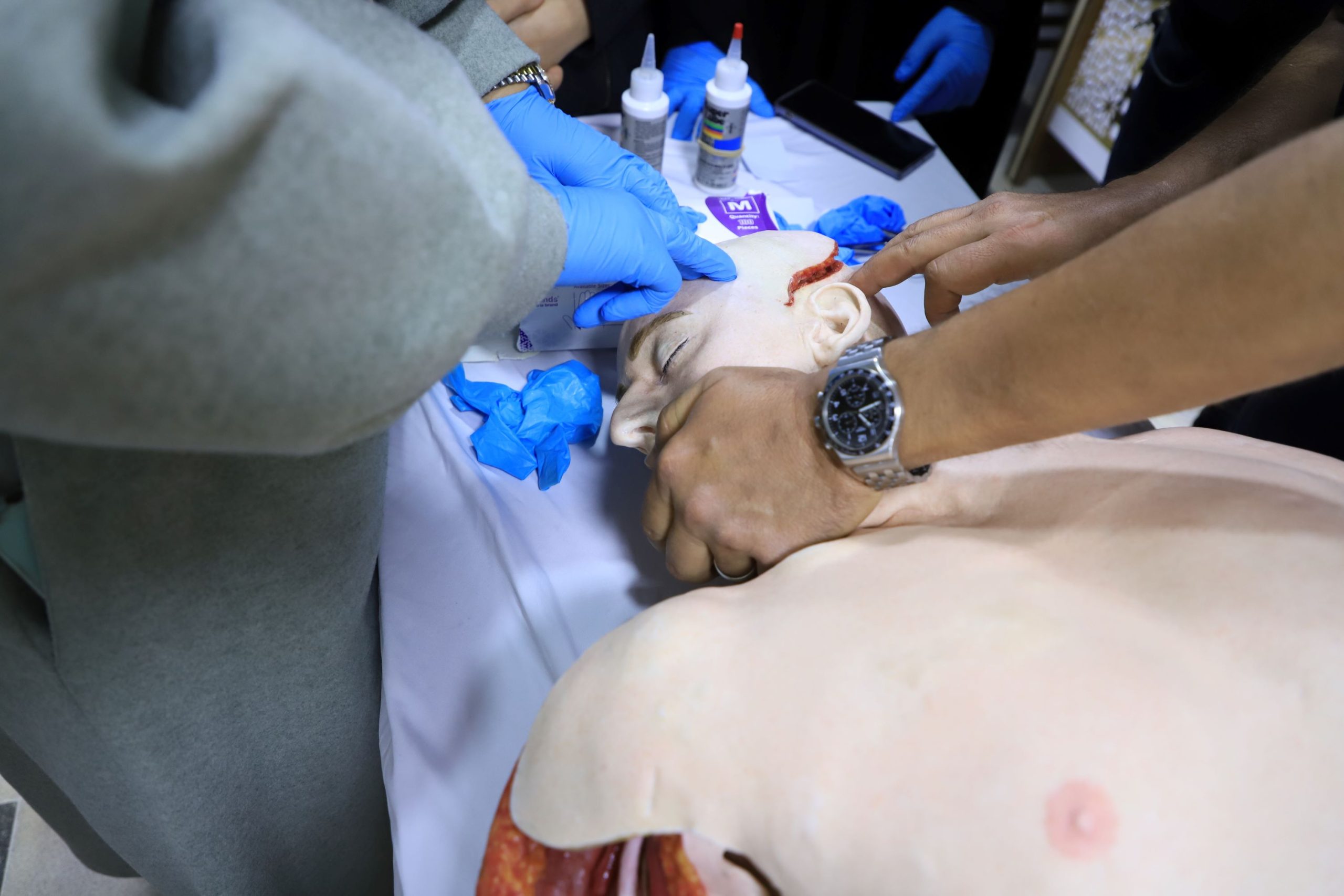
From collaboration to local leadership
From November 18 – 22, we delivered a specialised HEST course in Idlib, training 25 Syrian doctors. This marks a milestone in our partnership with WHO and our broader localisation efforts. Notably, this training was entirely led by our Syrian faculty, supported by UK-Syrian faculty members, emphasising the importance of building sustainable, local capacity.
“The new generation of surgeons must learn all of these skills delivered on our courses to save more lives” - Dr Mahmoud Hariri, faculty member
The training focused on equipping participants with critical skills in trauma response, including the management of blast injuries, gunshot wounds, and advanced surgical interventions required in conflict zones. This hands-on course, tailored to address the specific challenges of Northwest Syria, underscored the power of collaboration and the value of empowering local medical professionals to lead in their own communities.
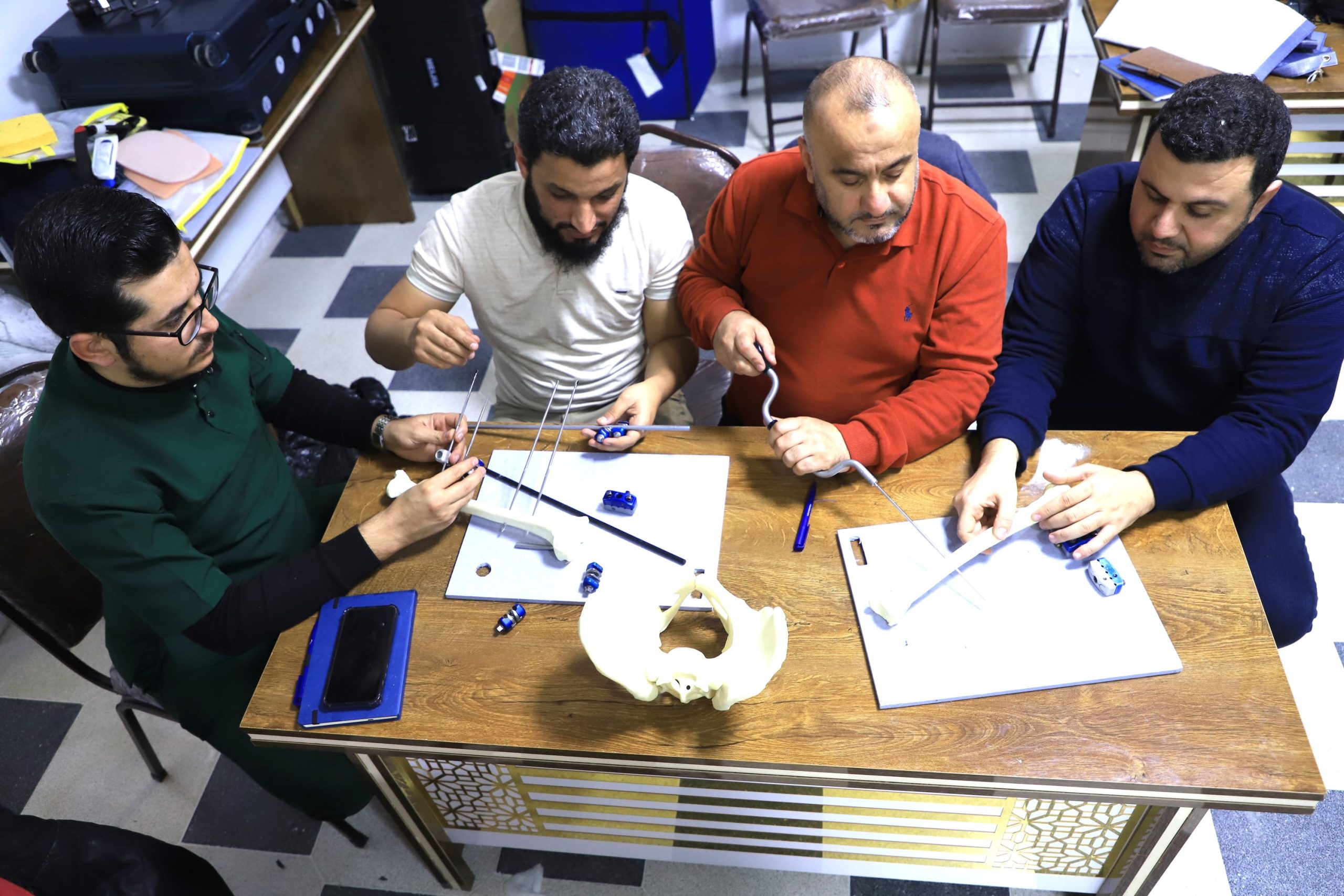
Building resilience amid crises
This mission is part of WHO’s broader plan to enhance the capacity of Northwest Syria’s healthcare system, which prioritises equipping hospitals with essential supplies, creating dedicated triage areas, and improving coordination across trauma networks. Together, we aim to strengthen the region’s ability to respond to mass casualty incidents, ensure communities receive life-saving care during these volatile times, and work towards the sustainable development of the trauma system in Northwest Syria. Building on this foundation, we will continue to contribute to capacity-building efforts in the coming years, with plans to deliver HEST, HEST-A, and HEST-O&G courses early next year.
The devastating events of this past week in Northwest Syria, with fresh waves of airstrikes and escalating violence, have once again underscored the region’s urgent need for enhanced trauma care. We are humbled to have been there just days before, providing Syrian doctors with the life-saving skills they now rely on to manage the growing number of critically injured patients. Our training was not just a response to the immediate need but a long-term investment in the resilience and readiness of Syria’s healthcare system.
Find out more about our work in Syria
“If this training can work in Gaza, it can work anywhere else.”
Dr Israar Ul-Haq joined our HEST-UK (Hostile Environment Surgical Training-UK) course in Bolton to improve his trauma surgery skills before entering the heart of Palestine’s crisis – the Gaza Strip.
Dr Israar Ul-Haq is a doctor with a primary focus on urgent and pre-hospital care. Volunteering his expertise, Dr Ul-Haq joined two separate missions to Gaza, serving in Khan Younis and Deir al Balah.
“As I entered Gaza I felt a mix of emotions—eager to employ the skills I learned from HEST and help those in need, yet wary of the drones I can hear as soon as I entered.”
With minimal resources and an overwhelming patient load, ranging from 500 to 1000 individuals daily according to Dr Ul-Haq, the medical staff faced immense challenges. The injuries they treated ranged from blast injuries and crush wounds, to traumatic amputations and fatal head injuries, or gun shot and sniper wounds. Techniques learned during the HEST course, such as medical triage or procedures for getting access to the chest quickly, such as thoracotomies, were immediately put into action.
It impacted every aspect of my work in Gaza
Dr Ul-Haq shared: “The course impacted every aspect of my work in Gaza, such as understanding the local environment and the types of injuries we encountered. Whether it was performing chest drains, managing blast injuries, conducting debridement, or treating burns, the training equipped me with the necessary skills I needed.
The lectures on burns were very useful, they directly influenced our treatment protocols. Techniques like thoracotomy and bleeding control learned during the course became standard procedures in our daily practice. The emphasis on conducting primary and secondary surveys, along with fast scanning helped us to quickly assess and address critical issues in a high-pressure setting."
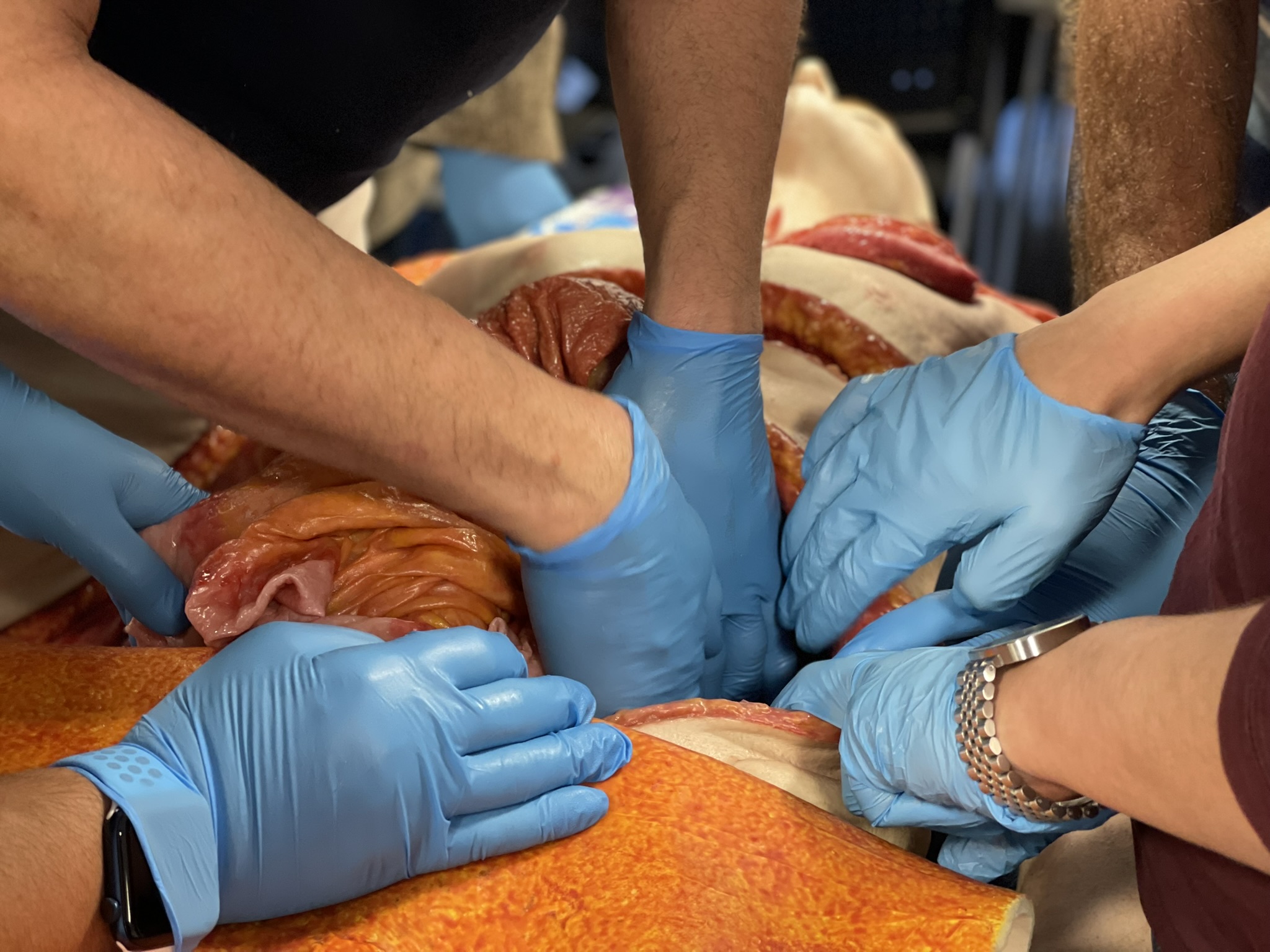
Patients that stay with us
“One patient's case is stuck in my head. He presented with a shrapnel injury to his back, which had penetrated his thorax. While we stabilised him initially, signs of Beck's triad (low blood pressure, distended neck veins, and distant or muffled heart sounds) alerted us to a possible cardiac tamponade (a serious condition where fluid builds up around the heart) - I had learned to identify this issue through fast scanning during the course. We rushed him to the operating theatre. Employing techniques like the clamp shell procedure, we successfully removed the bleeding around his heart, stabilising him.”
“We had a four-year-old brought into the hospital with a pneumothorax, severe head injuries, and burns. We immediately admitted the child to the ICU. We performed a chest drain to treat the pneumothorax and employing rapid sequence induction (a method to quickly administer anaesthesia and secure the airway) to stabilise the child's condition. We debrided the wounds at the back and used fluid therapy to manage shock and maintain stability.”

Our course is not just about building medical skills, it's about cultivating problem-solving abilities in the most challenging of circumstances. In environments where resources, staffing, and traumas are at their peak, the course empowers doctors to think laterally and use whatever limited resources they have. From using different pain management drugs to conducting fast scans to evaluate a patient's condition rapidly, every aspect of the training is geared towards equipping doctors with the tools they need to save lives, no matter where they are.
“Upon arrival, another patient had no bleeding or shrapnel injuries, but vitals would not stabilise. drawing on what we learned from the HEST course, we identified a left-sided pneumothorax. Despite initial stabilization efforts, the patient's vital signs remained unstable,” shared Dr Ul-Haq. “I often used the fast-scanning technique taught in the course. ; I detected an additional right-sided pneumothorax. Without hesitation, I proceeded to insert a chest tube, a procedure ingrained in our training. Had we delayed any longer, the outcome could have been disastrous.”
“Gaza is facing unimaginable suffering, and HEST was incredibly helpful there. If it can work in Gaza, it can work anywhere else too.”
READ MORE ABOUT OUR WORK FOR PALESTINE
The anaesthetist in a war zone
It takes a team to save a life in a war zone. Recognising the vital need for anaesthetists in conflict, we developed a bespoke anaesthesia course, to prepare anaesthetists for working in war hospitals. One of our experienced trainers, Dr Hussein Nagi, recently taught anaesthetists from Kuwait who are heading to Palestine.
Managing pain in different ways
“Treatment and anaesthesia do not end in the operative theatre. In a war zone, you could have a whole ward of people with post-operative pain, for example after amputations. Anaesthetists must do what they can with what they have to continue their care," shared Dr Nagi in Kuwait.
"A colleague once shared that a boy was screaming in the night with phantom limb pain after getting an amputation, he was shouting ‘my toe is hurting’. His toes were not there.
They found a stock of epidural kits in their hospital (for maternal care) and gave it to him through a catheter – the boy was almost pain free. You can resolve severe pain, by nerve blocking, with a range of drugs. You just need to be able to adapt to your environment.”
Our course teachers share tips and tricks just like this, with the goal of making anaesthetists adaptable to the challenges of a conflict-affected environment.
The science behind war
A trainee from Kuwait, during our latest HEST-A course in the Middle East, shared: “The trainers were combining their war experience with theoretical teaching, which added a lot to the course – showing us what to expect.
There were three main sessions that I learned the most from. Damage control, the ballistics science behind bullets and bombs, and the chemical weapons session. They’re not taught during medical training so knowing more about them, how to deal with these situations, understanding the science to then anticipate what we may meet in A and E, was the highlight of the course.”
Triage is critical
“It was an impressive course. The most interesting part for me was the triage, and making decisions using the information we have learned over years in studies, but applying it to a conflict zone.
"You have to adjust and accommodate to different situations, especially areas where you don’t have all the resources."
Gaza today urgently needs resources, food, water, equipment and man power. From what we hear from doctors on the ground, medical resources are much needed. It is very desperate.”
We have trained over 80 surgeons and anaesthetist in the UK and Kuwait who have, or intend to, volunteer their skills in Palestine's frontline hospitals. We will continue to upskill doctors in support of the people of Gaza.
SUPPORT OUR TRAINING
Preparing 36 Kuwaiti doctors for surgery in Gaza
With support from the Foreign Common Development Office (FCDO) and Kuwaiti Red Crescent Society (KRCS), we upskilled 24 Kuwaiti surgeons and 12 anaesthetists who intend to volunteer as humanitarians in Gaza. This marks our first direct partnership with the UK government.
Faculty Lead: Dr Ammar Darwish. Surgical Faculty: Dr Mahmoud Hariri, Professor Steven Mahoney, Dr Saladin Sawan, Dr Juan Robinson. Anaesthesia Faculty: Professor Pete Mahoney, Dr Oliver Harrison and Dr Hussein Nagi.
Kuwait is home to over 4.2 million people. Sandwiched between Iraq and Saudi Arabia, Kuwait is a small but influential country in the Middle East. As the war continues to wage in Gaza, a number of Kuwaiti doctors have plans to volunteer their skills on the frontline. Upon invitation from the FCDO and KRCS, we were pleased to upskill 36 doctors and prepare them for complex trauma injuries.
Our Co-Founder, Elly Nott, said:
“Recognised by the UN as a Humanitarian Center and embodying the values of charity and humanity, Kuwait is a natural partner for the David Nott Foundation. During this mission, we trained 24 surgeons and 12 anaesthetists in partnership with the Kuwaiti Red Crescent Society and the British Embassy, Kuwait.
The doctors have been trained in surgical skills essential for saving life and limb and will contribute to relief campaigns and humanitarian initiatives in the region. There is sadly no end of need for their skills in the world at present and we look forward to further collaboration with our colleagues here in Kuwait for the benefit of those who suffer in conflict.”
The skills required by doctors in Gaza at this time extend far beyond surgery. Being calm in a crisis, able to adjust to the needs of the patient in front of you and adapt to the hospital’s resources – or lack of - are absolutely vital. Doctors and anaesthetists that rely on innovative surgical tools or drugs will only have so much impact in active war zones.
Consultant Anaesthetist and DNF Faculty Trainer, Professor Pete Mahoney, said:
“In conflict zones, there may not be reliable electricity, water or access to medical gases such as piped or cylinder oxygen. You need to be able to pivot and use something called ‘draw-over’ anaesthesia to deliver suitable medication. This is when the use of simple masks or a bag can be used to pull volatile agents (anaesthetic medications) into the patient’s body.
We also taught the Kuwaiti doctors how a simple anaesthesia machine can be constructed from components as they may need to build one in the field with whatever the hospital has. It is critical that humanitarian doctors are able to adapt.”
We know from our Faculty Lead in Palestine that doctors on the ground don’t always have the time or available tools to fix bones together with metal pins. To give doctors other options that require less equipment, we taught Kuwaiti doctors how to set bones with plaster casts, which can help breaks to heal in the absence of pins.
The British Ambassador to Kuwait, Mrs Belinda Lewis, said:
“The fact the UK government’s first partnership with the amazing David Nott Foundation took place in Kuwait is testament to the strong and productive relationship between our two countries. This combination of British and Kuwaiti expertise will undoubtedly support the medical response to the dreadful suffering in Gaza.
I am grateful for the assistance of a number of people in Kuwait who have helped me to bring in this expert team from the UK, and I would like to pay special thanks to Professor Ghassan Abu Sittar, veteran war surgeon and humanitarian, who first suggested this valuable partnership to me.”
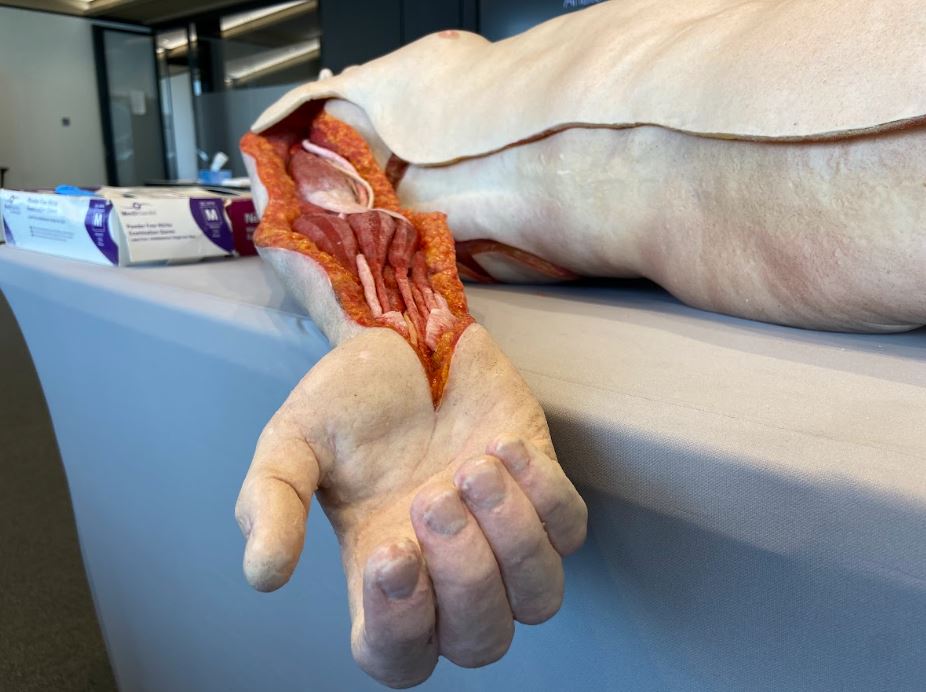
President of the Kuwaiti Red Crescent Society and former Minister for Health in Kuwait, Dr Hilal Al Sayer, said:
"On behalf of the Kuwait Red Crescent Society, I extend my appreciation to the British Embassy for their facilitation of the training course throughout this process. I also extend our sincerest gratitude to the David Nott Foundation for their invaluable expertise. Their guidance has empowered our esteemed consultants with the skills needed to navigate the complexities of emergency medical care as volunteer medics in conflict zones whose dedication serves as a testament to the spirit of humanity that defines our National Society.
Last, but certainly not least, I extend my heartfelt thanks to the National Bank of Kuwait for their generous support, we are truly grateful for their partnership.
I am immensely proud of the collaboration that has characterized our time together and am confident that we will carry forward the lessons learned in our shared mission to serve humanity with compassion and expertise."
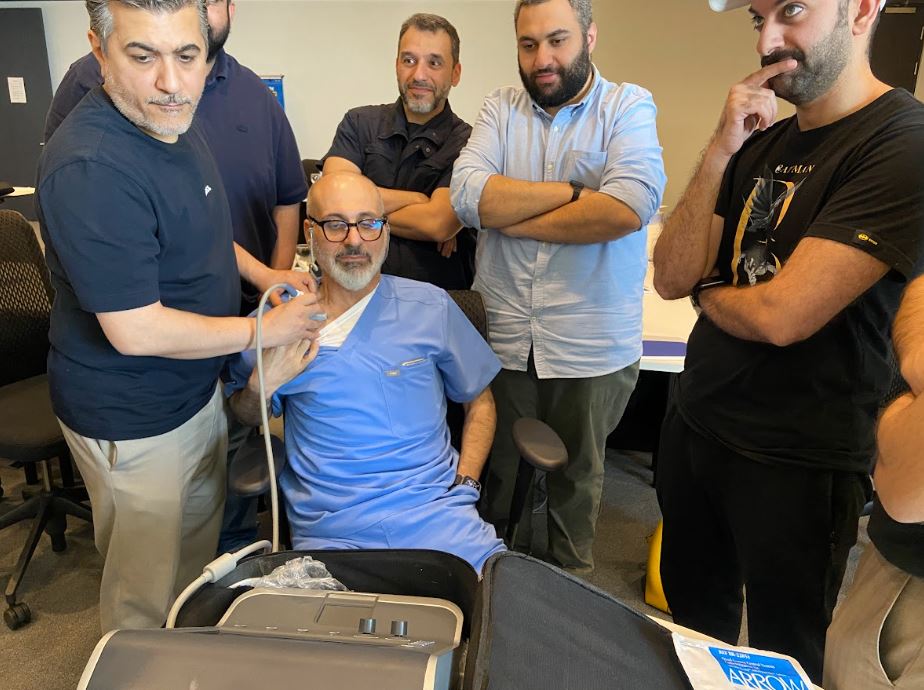
Until we can support and upskill doctors on the ground in Gaza, we will continue to do all we can from a distance. The delivery of our surgical and new anaesthesia courses to Kuwaiti doctors who intend to enter Palestine as humanitarian volunteers, forms part of our unwavering commitment to the ongoing crisis.
SUPPORT OUR TRAINING
“The patients. The families. They’re all in my head.”
Our Co-Founder David Nott recently travelled to Rafah, Gaza, to help treat the thousands suffering from war injuries, malnourishment, and everyday ailments that have progressed to life-threatening conditions because of delayed treatment. Here, David shares what he witnessed, what the urgent medical needs are on-the-ground, and how those he met are tattooed onto his mind.
After travelling from Cairo and getting closer to Gaza, it was quite a shocking experience. At the Rafah crossing, you could see miles worth of trucks in a queue trying to get in.
Driving through Gaza, it was like an enormous refugee camp with tents everywhere. Every single place that wasn't occupied by somebody had a tent on it. Most of the tents were so packed against each other it was difficult for people to walk.
"Thousands and thousands of people were in a small area. They had nowhere to go."
Treating those more likely to live
The hospital I was working in was called Al Najjar Hospital, the only semi-functioning hospital in Rafah. It was small, with a limited number of beds, but ended up housing thousands of people. Every corner was full. Patients were in the corridors, all over the wards, lying on the floor, five people where one might stand. There were people on the floor that were dying, some that had died - people crying out for help.
I had to step over people to get to patients. I had to make rapid decisions on whether or not they could be saved – decision-making techniques that we teach to those that attend our courses.
The hospital only had two operating theatres. There was no intensive care unit and no ventilators, so I had to decide which patients should be operated on with the best possible outcome. On ward rounds we reviewed those that had been treated, but many had infections because of limited sterile space or antibiotics.
18th century illnesses
"Because thousands of people have been compressed into small spaces, and many haven’t sought medical care for their everyday conditions, the clinical needs in Gaza today are astonishing."
It’s not just war wounds that doctors face – ruptured appendices, hernias, ulcers, gangrene. General surgery has been delayed for months on end and people are dying or losing limbs as a result of problems that could have been resolved quickly.
This is the reality of trauma in war – some traumas that were not traumas to begin with become life-threatening – racking up death tolls even further.
"Outside of war wounds, 21st century doctors are dealing with 18th century illnesses."
Children with chest infections were developing a condition called empyema - their infections had become so bad that their lungs were filling with pus. I’d never seen that before – it’s an 18th century condition that you would never see today.
Post-operative care felt impossible. Say you amputate somebody’s leg, there’s nowhere for them to go to recover safely. Tents aren’t sterile and it has been so cold, with the wind coming off the beach.
Calm amongst the chaos
Despite the chaos, Gazan doctors are truly outstanding. They were so warm and helpful. They were grateful that people were there to help, and together we did everything we possibly could.
This war zone is different to the others I’ve been in. The volume of people and the lack of basic medical or human resources made it incredibly challenging.
They urgently need field hospitals, more staff, a huge amount of medical resources. They need more doctors, nurses, rehabilitation services, physiotherapists. But not only that, they need a safe place for patients to go to recover after operations. Their medical aid needs are huge and doctors in the field need to be supported.
"Seeing Gaza reminds me of the vital importance of our foundation’s work. Training doctors, operating on patients in war zones, bearing witness to doctors’ needs on the ground, I’m more driven than ever to help the charity grow so we can reach even more people in need."
The patients, the families, they’re all in my head. They will always stay in my head.
SUPPORT OUR TRAINING IN PALESTINE
Bearing witness to the medical needs in Gaza
Our Medical Director Dr Ammar Darwish embarked on an operating surgical mission to Gaza to offer his trauma surgery skills to those most in need. As he crossed the border into the besieged territory, he faced trucks held up for miles, filled with much-needed aid.
“The needs in Gaza - it was hell on earth”
As Dr Darwish travelled deeper into Gaza, he observed the expanse of makeshift tents, shelters for internally displaced families. Some had no tents at all, resorting to crafting shelters from plastic sheets that offered little protection from the cold and wet weather.
Entering Khan Yunis Hospital, Dr Darwish was met with exhausted medical staff who were battling with limited supplies. Vast numbers of patients with extreme injuries came through the doors and difficult choices had to be made within minutes on who could be saved.
Adapting to an impossible environment
Lack of electricity and water are causing numerous health complications. Without electricity, patients in need of ventilation struggled to breathe. The absence of water prevented the sterilisation of medical tools. Medication, antibiotics, painkillers, and even anaesthesia were sparse – basic resources that should be present in any hospital.
Children with severe injuries from shrapnel lay in beds with little to no relief due to lack of medical resources.
“I met a very scared six-year-old boy that had a shrapnel injury in his abdomen. Because of the complexity of the injury, and because of limited resources such as antibiotics, the boy’s abdomen was open and there were a lot of holes in his bowels. Anything he ate or drank was leaking out of his abdomen. That child had not had any food to eat, or a proper drink, for a whole month, he was a skeleton.”
Stretched to limits
Despite the chaos, resilience and humanity ran through the Gazan people. Local medical staff welcomed Dr Darwish and his team, despite managing the loss or unknown status of their homes or family members. They were stretched to their limits, with only nine operating hospitals left of all the 36 hospitals in Gaza.
“You cannot but compare it to our work in a UK major trauma centre, where for one trauma patient, you might have six, seven, even 10 doctors treating them. In Gaza you are one doctor for 10 people, 15 people, which means you have to make really heavy decisions on who to treat. It sits heavy on my heart that there were many children we could not even see to in time.
I've been part of over 45 global missions in conflict zones, with Syria, Aleppo, being one of the most challenging. This mission to Gaza was the most difficult mission that I've been through physically, mentally, even psychologically, because of the amount of injury that I witnessed and the amount of devastation and carnage we were faced with and with only basic supplies and resources.”
Medical needs for years to come
“The number of injured people now in Gaza has exceeded 70,000. If you can imagine the complexity of these injuries - these patients will need years of medical care, surgical operations, physiotherapy, and a lot of resources to reconstruct their injuries. There is a huge need for humanitarian aid, but first there must be a ceasefire.”
We have provided training to 79 UK surgeons who are preparing to or have already travelled to Gaza to provide life-saving aid. Many more are scheduled to depart. Our aim remains steadfast and unwavering – to ensure everyone has access to safe, skilled surgical care.
We are committed to supporting the Palestinian people until we are able to train in-country again.
SUPPORT OUR TRAINING IN PALESTINE
“Maternal health - it's a societal barometer.”
Every two minutes, a woman loses her life to preventable causes related to pregnancy and childbirth. These staggering statistics stress the need for action. In humanitarian crises, where access to healthcare is severely limited, maternal care becomes even more critical.
“800 preventable maternal mortalities are happening every day, and a woman dies every two minutes from a preventable cause. So that's women dying through pregnancy and pregnancy related conditions,” shared Dr Pippa Letchworth, our Faculty Lead for Obstetrics and Gynaecology.”
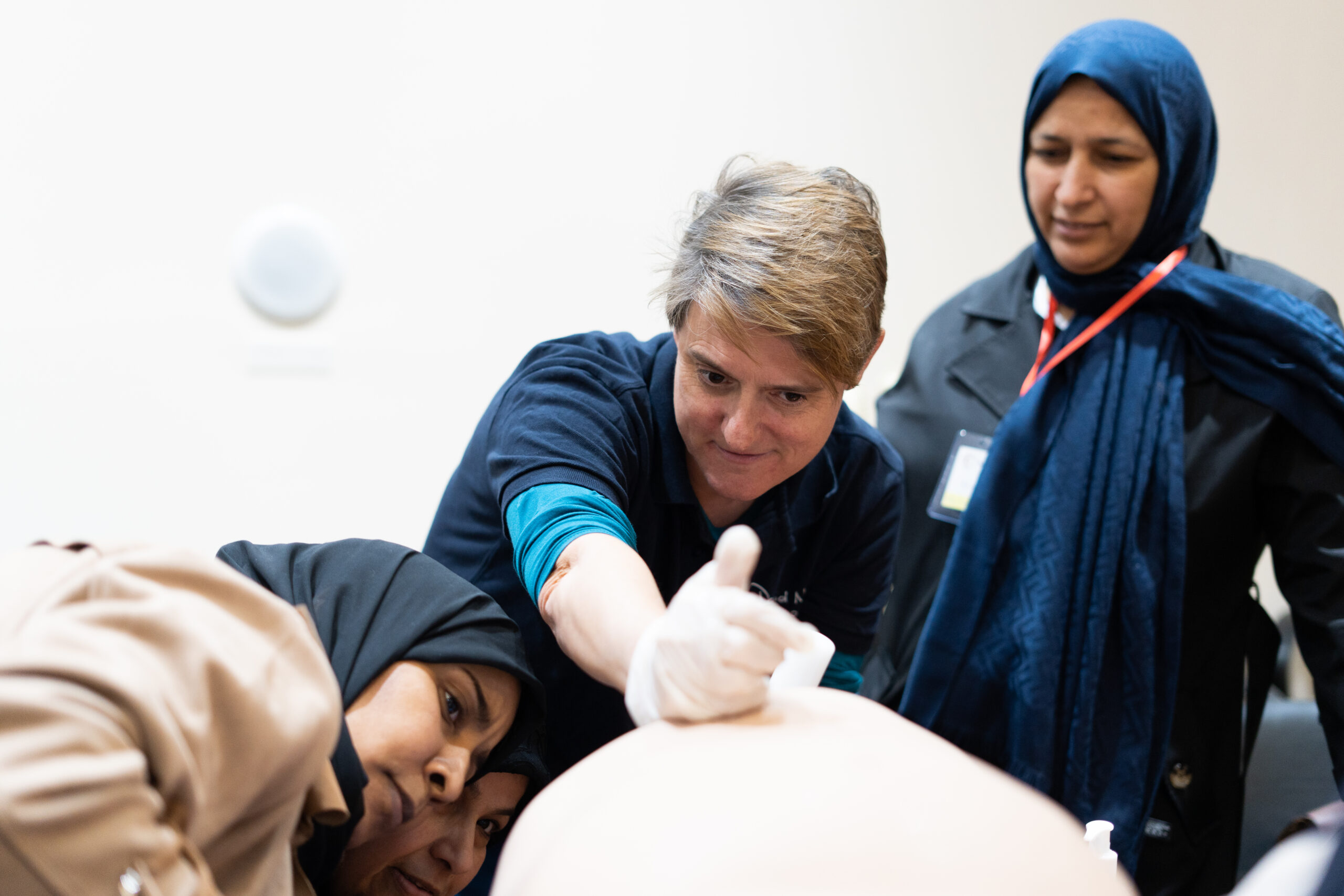
This sobering reality is what drives our passionate team to develop an obstetrics and gynaecology course aimed at addressing the most pressing challenges in maternal healthcare. In crisis settings, where resources are scarce, the course equips healthcare professionals with the skills needed to perform life-saving surgeries, particularly focusing on addressing the top global killers of women - haemorrhage, obstructed labour, sepsis, and unsafe abortion.
“75% of displaced people are women and children, and one of the five of those women will be pregnant.”
The course covers a wide spectrum of topics in maternal and neonatal healthcare in crisis. Participants begin with trauma training before transitioning into obstetrics to understand the complexities of childbirth emergencies.
Emphasis is placed on neonatal resuscitation techniques with the goal of reducing the number of stillbirths. Subsequent sessions address postpartum haemorrhage management, perineal repair, and navigating challenging deliveries like impaction and breech positions. The course also covers disruptive delivery, crucial for situations where doctors have limited access to caesarean sections.

Beyond the medical realm, our trainers advocate for a holistic approach to maternal health in their teaching. It's not just about reducing mortality rates, it's about understanding the wider implications of maternal deaths on families, communities, and societies at large. Children left motherless are at a significantly higher risk of mortality and developmental issues, perpetuating a cycle of vulnerability.
“There needs to be a call to arms to improving maternal health.”
We must advocate for women's rights, improving doctors access to education and dismantling systemic barriers that perpetuate maternal mortality.
DONATE
Doctors rapidly trained to treat trauma injuries in Gaza
During a remarkable four-day Hostile Environment Surgical Training (HEST) course, surgeons and anaesthetists from the UK, Germany, Sweden, Norway and Qatar gathered in Bolton to learn how to treat trauma injuries in the Gaza Strip.
Organised in two weeks in collaboration with Palmed, 42 doctors headed for the Middle East were trained to treat complex trauma injuries incurred in the Israel-Gaza conflict. This course not only marks a significant step towards preparing medical professionals for future missions in Palestine but also reflects a shared commitment to saving lives in conflict zones.
"Thank you to the David Nott Foundation. Without them, this training would not have been possible. Together, we are organising this course to assist the people in the Gaza Strip once it is safe and travel becomes feasible. The response from numerous doctors expressing their desire to help has been overwhelming, and we are hopeful to conduct a second course in the coming weeks." - Riyadh Al Masharqa, Plastic surgeon, PalMed
Addressing urgent medical needs in Gaza
The course was organised in response to the pressing humanitarian crisis in Gaza, Palestine. According to on-the-ground partners, medical professionals are stretched to their limits and hospitals are overwhelmed.
The group included specialists in orthopaedic surgery, cardiothoracic surgery, obstetrics and gynaecology, paediatric anaesthesia, and general surgery. Some brought valuable, first-hand experience from regions affected by conflict, like Afghanistan and Syria, while others joined to grow their understanding of how to treat war wounds before heading on mission.
"I'm excited about expanding my skill set beyond obstetrics and gynaecology to acquire new capabilities that will benefit mothers and their infants in Gaza and the West Bank. I recognize the desperate need for assistance in this region. This course is unique as it combines obstetrics and gynaecology with trauma care. This training aims to address complex challenges comprehensively and I look forward to it.” - Dr Iman Al Mabhooh, Obstetrician and Gynaecologist

A troop of volunteers
For the very first time, 11 FDNF volunteers from our Friends of The David Nott Foundation (FDNF) and Trainees of The David Nott Foundation (TDNF) societies volunteered to help arrange and assist during the course. This joint effort meant it could be organised at lightning speed, rapidly creating a network of well-trained war doctors.
“Given not only the humanitarian crisis in Gaza but with the targeting of healthcare workers in particular it's never been more important to strengthen our healthcare colleagues and equip them with the skills to do their incredibly difficult jobs and to support them through a very precarious situation.” - Nadia, FDNF Manchester President

Our surgical HEST and anaesthesia courses were held simultaneously, demonstrating our commitment to enhancing the skills of all those striving to preserve life in the operating theatre.
"What has been great about this course is meeting people that have experienced things in the field. From the anaesthetics point of view, it's been helpful to learn how they deal with limited resources and supplies, and we have been using airway mannequins and practicing with video scopes."- Dr Douglas Philpott, Anaesthetist
We’re committed
As war continues to rage, we are working on a second surgical training course with the goal of upskilling even more frontline medical professionals. We won’t stop empowering doctors with the knowledge needed to save lives and limbs against the odds.
Our latest training in Palestine
Our action in response to the Israel-Gaza war
As a humanitarian organisation delivering surgical training to doctors in regions affected by conflict and catastrophe, we have been devastated by the recent escalation of violence in the Middle East.
We have been in contact with our partners, including Juzoor and Action for Humanity, local faculty of trainers, and those we’ve previously trained, to gather a comprehensive picture of the injuries being encountered and needs of medical professionals on the ground.
Reports reveal that many healthcare facilities are under severe strain. Emergency departments are under immense pressure, with growing numbers of trauma injuries due to shellings, shrapnel or collapsed buildings. Supplies at blood banks and basic medical resources are also running low.
Our action
To support hard-to-reach medical professionals at this time, we:
![]() Turned our world-class surgical training course into a series of short videos that can be watched in their own time. We’ve shared our English and Arabic videos with local doctors across the region.
Turned our world-class surgical training course into a series of short videos that can be watched in their own time. We’ve shared our English and Arabic videos with local doctors across the region.
 Shared our videos with local partner medical professional networks, ensuring even more doctors in need can benefit from the resource.
Shared our videos with local partner medical professional networks, ensuring even more doctors in need can benefit from the resource.
![]() Invited local doctors to our global case study discussion forum to share patient cases and gain advice from peers around the world.
Invited local doctors to our global case study discussion forum to share patient cases and gain advice from peers around the world.
![]() Exploring a bespoke discussion forum for doctors affected by this crisis, where our faculty of trainers and others can offer advice and surgical guidance more personally.
Exploring a bespoke discussion forum for doctors affected by this crisis, where our faculty of trainers and others can offer advice and surgical guidance more personally.
As the emergency unfolds, we will continue to monitor how best to support doctors under pressure until we are able to deliver our surgical training course in person.
Elly Nott, our Co-Founder and CEO, said:
“We are appalled by the violence and loss of life in Israel and Gaza and extend our condolences to all who have lost loved ones.
Following the attacks, many are contending with injuries of vast complexity, scale and intensity.
Healthcare workers should be able to deliver life-saving care to their communities free from the threat of violence and parties should uphold their obligations under international humanitarian law.
Access and protection for humanitarians delivering assistance to those civilians affected is essential.”
